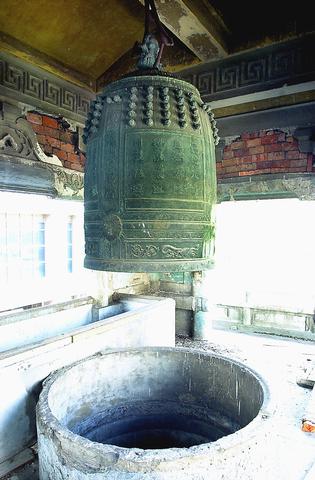For years, Master Yuan Ling (
"What we're asking for isn't very much. We've waited so long and still no progress has been made," Master Yuan Ling said.

PHOTO: CHEN CHENG-CHANG, TAIPEI TIMES
And while he has waited for the restoration's approval, the government has gradually moved in on the land surrounding the temple, even after the tower was designated a municipal historic landmark in 1997.
The city's Bureau of Cultural Affairs has been reviewing plans for the restoration, but say that until their review is completed, money for the project cannot be dispensed.
"We'll start the second round of the reviewing process next Wednesday. If everything goes well, the restoration project should be completed in July," Li Bin (李斌), deputy director of the cultural affairs bureau, said.
In response, Taipei City Councilor Lee Hsin (
"Since the City Council has already approved the NT$24 million budget for the restoration of the bell tower, there's no point in withholding the money," Lee said.
"Historical landmarks are the roots of every culture. If they're not well taken care of, the culture is a rootless one," Lee said.
Construction on the temple complex, located at the intersection of Linsen South Road and Jenai Road, first began in 1908. It originally covered an area of 4,500 pings (or 14,850m2) and consisted of the Soto Zen Center (曹洞宗台北別院), the Kuanyin Zen House (觀音禪堂), the Taipei Junior High School (台北中學), and the bell tower.
The bell tower and the Tung Ho Zen Temple are the only two remaining buildings in the complex. The temple was originally called the the Kuanyin Zen House, and was renamed in 1946, about the same time that the complex and the land it was built on were donated by the Japanese colonial owners to the temple's former master, Master Hsin Yuan (心源老師父).
The central government tried to acquire the land from Master Hsin. But Hsin remained unwilling to part with the complex, so cultural officials had to wait until April 1970, one month after the 89-year-old master died.
Since it took-over, the area of the complex has gradually shrunk to 700 pings (or 2,310 m2) due to a large number of illegal buildings.
The most recent encroachment on the temple's land is a new bathroom pink 10-floor building called the Taipei Municipal Youth Recreation Center (台北市立青少年育樂中心), 50m away from the bell tower.
The center cost the city over NT$1 billion to build and is slated to be opened to the public in July. Meanwhile, Master Yuan Ling's temple and the bell tower continue to deteriorate.
While the 71-year-old tower was designated a municipal historical landmark in 1997, the city has failed to take any rehabilitative action, doing little to maintain the Japanese-style two-story building. The building is now filled with only dead birds and their droppings.
PFP lawmaker Chu has called on the city's Bureau of Cultural Affairs (
"I'm very curious to know why the city has failed to prohibit construction in the perimeter around the bell tower," Chu said.
The Cultural Heritage Preservation Law (
Officials of the city's Bureau of Education (
Master Yuan also wonders why in the world the bell tower was declared a historical landmark, but the temple was not.
"I don't know why the 84-year-old temple is considered less important than the 71-year-old bell tower," he said.

The Ministry of Foreign Affairs (MOFA) yesterday said it is closely monitoring developments in Venezuela, and would continue to cooperate with democratic allies and work together for regional and global security, stability, and prosperity. The remarks came after the US on Saturday launched a series of airstrikes in Venezuela and kidnapped Venezuelan President Nicolas Maduro, who was later flown to New York along with his wife. The pair face US charges related to drug trafficking and alleged cooperation with gangs designated as terrorist organizations. Maduro has denied the allegations. The ministry said that it is closely monitoring the political and economic situation

UNRELENTING: China attempted cyberattacks on Taiwan’s critical infrastructure 2.63 million times per day last year, up from 1.23 million in 2023, the NSB said China’s cyberarmy has long engaged in cyberattacks against Taiwan’s critical infrastructure, employing diverse and evolving tactics, the National Security Bureau (NSB) said yesterday, adding that cyberattacks on critical energy infrastructure last year increased 10-fold compared with the previous year. The NSB yesterday released a report titled Analysis on China’s Cyber Threats to Taiwan’s Critical Infrastructure in 2025, outlining the number of cyberattacks, major tactics and hacker groups. Taiwan’s national intelligence community identified a large number of cybersecurity incidents last year, the bureau said in a statement. China’s cyberarmy last year launched an average of 2.63 million intrusion attempts per day targeting Taiwan’s critical

‘SLICING METHOD’: In the event of a blockade, the China Coast Guard would intercept Taiwanese ships while its navy would seek to deter foreign intervention China’s military drills around Taiwan this week signaled potential strategies to cut the nation off from energy supplies and foreign military assistance, a US think tank report said. The Chinese People’s Liberation Army (PLA) conducted what it called “Justice Mission 2025” exercises from Monday to Tuesday in five maritime zones and airspace around Taiwan, calling them a warning to “Taiwanese independence” forces. In a report released on Wednesday, the Institute for the Study of War said the exercises effectively simulated blocking shipping routes to major port cities, including Kaohsiung, Keelung and Hualien. Taiwan would be highly vulnerable under such a blockade, because it

Conflict with Taiwan could leave China with “massive economic disruption, catastrophic military losses, significant social unrest, and devastating sanctions,” a US think tank said in a report released on Monday. The German Marshall Fund released a report titled If China Attacks Taiwan: The Consequences for China of “Minor Conflict” and “Major War” Scenarios. The report details the “massive” economic, military, social and international costs to China in the event of a minor conflict or major war with Taiwan, estimating that the Chinese People’s Liberation Army (PLA) could sustain losses of more than half of its active-duty ground forces, including 100,000 troops. Understanding Chinese